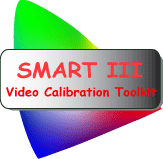SMART III - Video Calibration Toolkit
Steve Smallcombe's SMARTAVTWEAKS site

The most common mistakes people make using SMART
The most common mistakes people make using SMART
1. Aim the detector at the screen. This is wrong. Aim the detector at
the projector, as the light coming from the screen is almost always too
dim to make accurate measurements. The screen does not really affect the
color balance of the projector since screens are color neutral (including
gray screens). Since screens are also passive that don’t effect
gamma tracking or shadow detail either.
2. Ignore all those charts that are part of the SMART spreadsheet. Ideally
you could just look at the advice that SMART gives, but you are losing
an important source of information, in the case where you make a mistake,
the charts will often tell you what you did wrong. When people send me
their spreadsheets for help, I look at the charts. If a gain in increased
for a color, that color’s traces should go up. If a filter is added,
then the blue and green traces (red filter) should go down. If the traces
are very flat at all the high IRE level, then the contrast is much too
high. Learn to look at the charts as you do the various iterations of
the SMART process. You will not only learn how your projector works, but
you might also catch a mistake and save some time.
3. Forget to select the relevant custom color temperature (SONY 10HT and
11HT). I have seen this may times now. A user will modify custom 1, but
forget to select it as the active color temperature in the first menu
page. Obviously, in this case the changes made to the various settings
won’t apply.
4. Run with the contrast set much too high. I have seen many runs where
the various color intensity traces are completely flat at the high IRE
levels. This often happens after people have boosted the gain settings,
e.g. 255 for a 10HT, but not reduces the contrast an equivalent amount
to prevent blowing out the high end. Look at the traces!
5. Put the detector too far from the projector. If the detector is too
far from the projector, then the light falling on the detector can be
pretty dim at the low IRE levels. This leads to very long settling times
and long runs in general. Generally 2 to 3 meters should be about right.
Introduction to how SMART works
Frequently Asked Questions about SMART
Here is what's new is SMART III version 1.2
The Dummies Guide explains the SMART process in a non-technical way
Buy SMART III at EnhancedHT - your exclusive source for all SMART products
Having trouble? Learn the most common mistakes people make using SMART
Read about using bias lights to improve perceived black levels.
Here are some additional tips for the SONY projectors and solution to common problems.